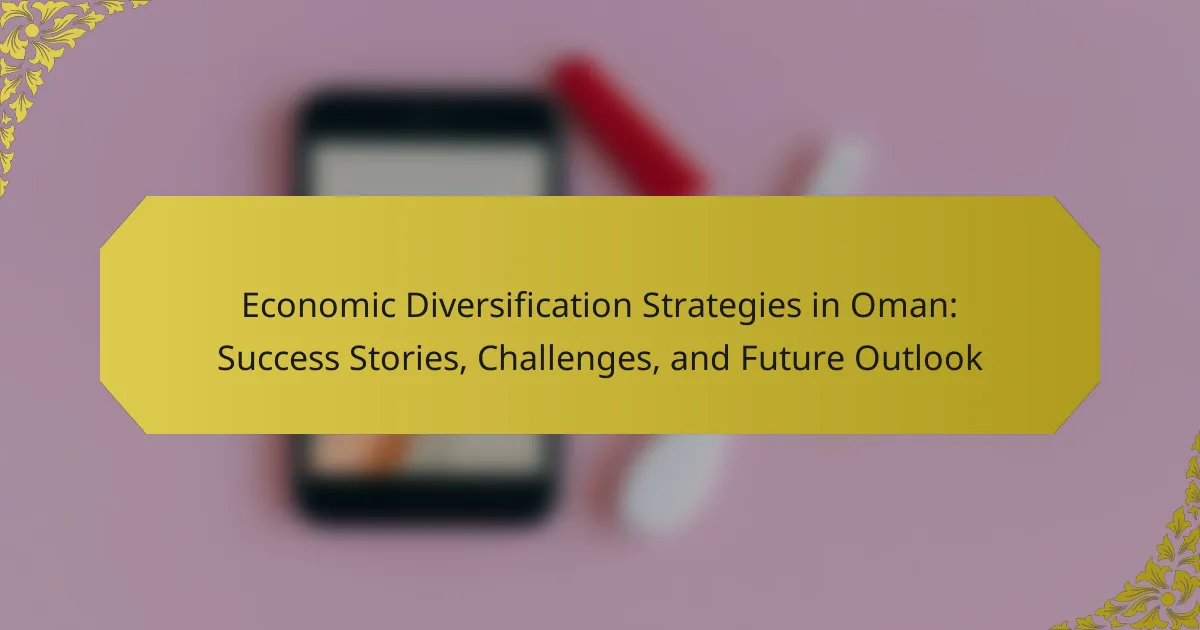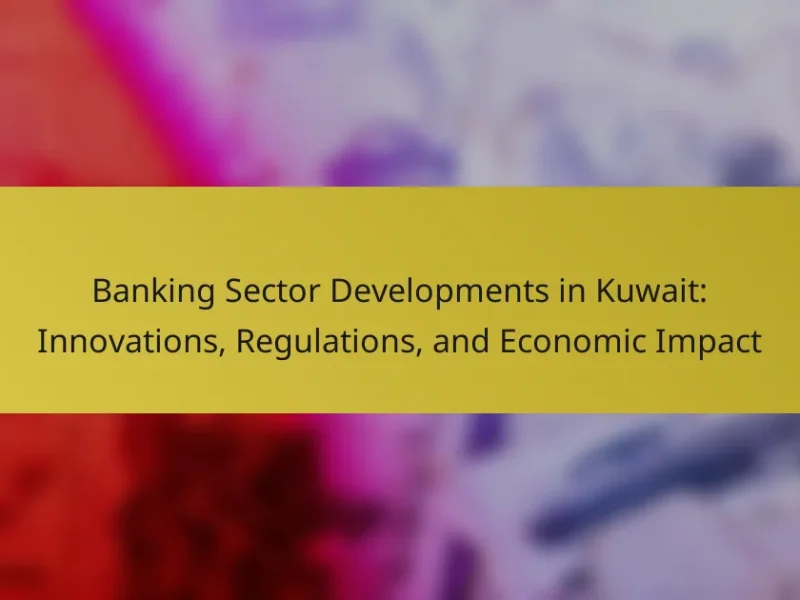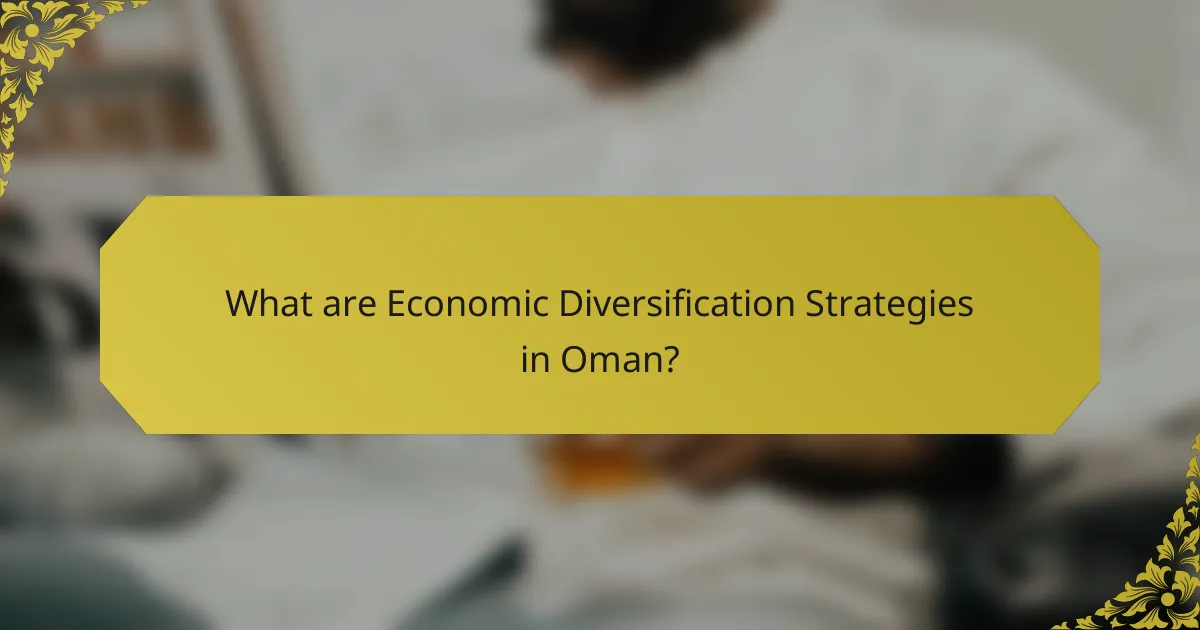
What are Economic Diversification Strategies in Oman?
Economic diversification strategies in Oman focus on reducing reliance on oil revenues. The government aims to develop sectors such as tourism, logistics, and manufacturing. Initiatives like Vision 2040 outline the roadmap for economic transformation. Investment in renewable energy is also a priority, enhancing sustainability. The Sultanate promotes foreign direct investment to stimulate growth. Special Economic Zones are established to attract businesses. Education and workforce development support these strategies. These efforts aim to create a resilient economy for the future.
Why is economic diversification important for Oman?
Economic diversification is crucial for Oman to reduce reliance on oil revenues. The oil sector contributes over 80% of government income. This reliance makes the economy vulnerable to oil price fluctuations. Diversifying into sectors like tourism, logistics, and manufacturing creates new revenue streams. It enhances job creation and stimulates local entrepreneurship. The government aims to increase non-oil GDP contributions significantly by 2030. Such strategies are vital for sustainable economic growth and resilience.
What are the main goals of economic diversification in Oman?
The main goals of economic diversification in Oman are to reduce dependency on oil revenues and to promote sustainable economic growth. Oman aims to develop various sectors such as tourism, manufacturing, and logistics. By diversifying, the country seeks to create jobs and enhance the skills of its workforce. Another goal is to attract foreign investment to stimulate economic activity. This strategy is crucial for achieving long-term economic stability. The government has implemented Vision 2040, which outlines specific targets for diversification. This includes increasing the contribution of non-oil sectors to the GDP. The focus on diversification supports resilience against global oil price fluctuations.
How does economic diversification impact Oman’s economy?
Economic diversification positively impacts Oman’s economy by reducing its dependency on oil revenues. This strategy encourages the development of other sectors such as tourism, manufacturing, and agriculture. As a result, Oman can create new jobs and stimulate economic growth. Diversification also attracts foreign investment, enhancing the country’s global economic standing. According to the World Bank, non-oil sectors contributed to approximately 70% of Oman’s GDP growth in recent years. This shift helps stabilize the economy against oil price fluctuations. Overall, economic diversification fosters resilience and sustainability in Oman’s economic landscape.
What are the key sectors targeted for diversification in Oman?
The key sectors targeted for diversification in Oman include tourism, logistics, manufacturing, and fisheries. The Omani government aims to reduce dependence on oil revenues. Tourism is promoted through initiatives to enhance cultural heritage and natural attractions. Logistics is being developed due to Oman’s strategic location for trade routes. The manufacturing sector is encouraged to boost local production capabilities. Additionally, fisheries are prioritized to enhance food security and economic sustainability. These sectors are integral to Oman’s Vision 2040 economic development plan.
How is tourism being developed as a diversification strategy?
Tourism is being developed as a diversification strategy in Oman to reduce reliance on oil revenues. The Omani government is investing in infrastructure to support tourism growth. This includes building hotels, attractions, and improving transport networks. Various initiatives aim to promote cultural heritage and natural landscapes. The Sultanate’s unique geography attracts adventure tourism, including trekking and diving. Additionally, Oman is hosting international events to boost visibility. Statistics show that tourism contributed 3.1% to Oman’s GDP in 2019. The goal is to increase this contribution to 6% by 2040.
What role does agriculture play in Oman’s economic diversification?
Agriculture plays a significant role in Oman’s economic diversification. It contributes to reducing reliance on oil revenues. The sector supports food security and creates job opportunities. In 2020, agriculture accounted for approximately 3.5% of Oman’s GDP. The government promotes modern farming techniques and sustainable practices. Initiatives like the Agricultural and Fisheries Development Fund support farmers. Enhanced agricultural productivity can lead to export opportunities. Overall, agriculture is vital for a balanced and resilient economy in Oman.
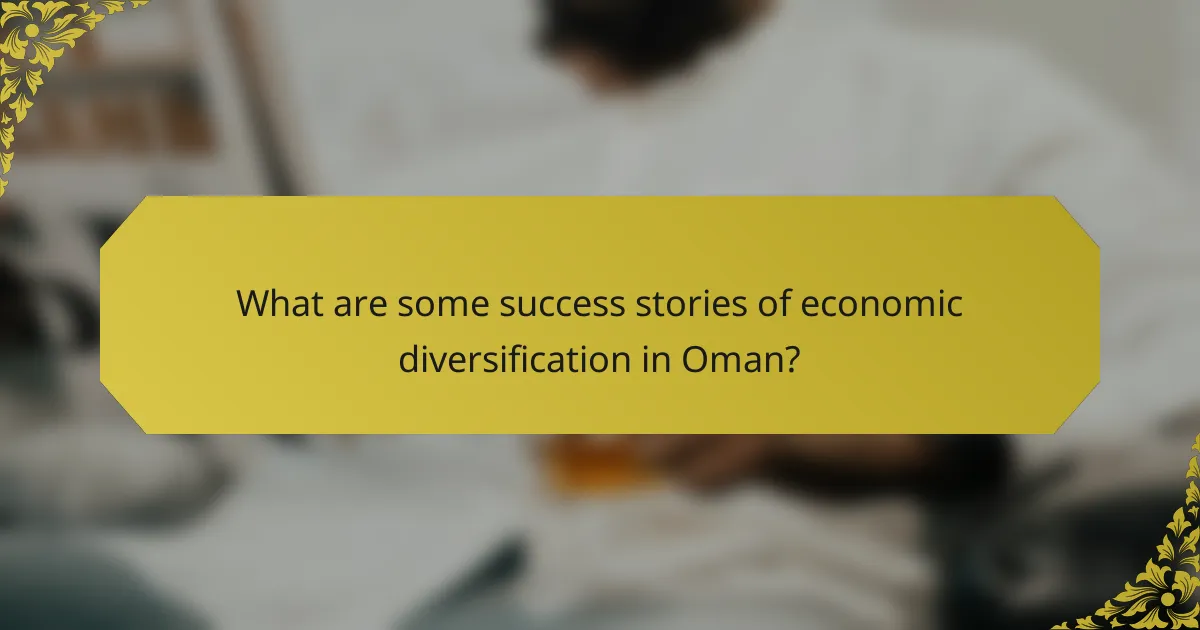
What are some success stories of economic diversification in Oman?
Oman has successfully diversified its economy through various initiatives. The development of the tourism sector is a notable success story. The government invested in infrastructure and marketing to attract tourists. This led to an increase in visitor numbers, boosting local businesses. The tourism sector contributed approximately 3.2% to Oman’s GDP in 2019.
Another success is the growth of the manufacturing sector. Oman established several industrial zones to promote manufacturing. This has attracted foreign investment and created jobs. For instance, the Duqm Special Economic Zone has drawn significant investment, enhancing economic activity.
Additionally, the agriculture sector has seen advancements. Oman has implemented modern farming techniques and water management systems. This has improved food security and reduced reliance on imports. The agriculture sector contributed about 2.5% to GDP in 2020.
These examples illustrate Oman’s commitment to economic diversification. Each sector’s growth demonstrates the effectiveness of strategic planning and investment.
How have specific projects contributed to Oman’s diversification efforts?
Specific projects in Oman have significantly enhanced the country’s diversification efforts. The Duqm Special Economic Zone has attracted foreign investment, fostering industrial growth. This project aims to reduce dependence on oil by promoting manufacturing and logistics sectors. Another initiative is the development of the Salalah Free Zone, which encourages trade and export activities. These zones have created job opportunities and stimulated local economies. The government’s investment in renewable energy projects, such as solar and wind, supports sustainable development. Additionally, initiatives in tourism, including the Oman Tourism Strategy, aim to boost non-oil revenue. These projects collectively contribute to a more resilient and diversified economy.
What lessons can be learned from successful tourism initiatives?
Successful tourism initiatives demonstrate the importance of community involvement and sustainable practices. Engaging local communities fosters a sense of ownership and pride. This leads to better visitor experiences and authentic cultural exchanges. Sustainable practices protect natural resources and enhance long-term viability. For example, the World Travel and Tourism Council reported that sustainable tourism can lead to a 20% increase in local economic benefits. Additionally, effective marketing strategies are crucial for attracting visitors. Successful initiatives often utilize digital platforms to reach wider audiences. Data from the United Nations World Tourism Organization shows that 70% of travelers research online before booking. Collaboration between public and private sectors also enhances tourism success. This partnership can lead to improved infrastructure and services. Overall, successful tourism initiatives provide valuable lessons in community engagement, sustainability, marketing, and collaboration.
How has the agricultural sector seen growth through diversification strategies?
The agricultural sector has seen growth through diversification strategies by expanding crop varieties and improving market access. Diversification reduces reliance on single crops, which enhances resilience against market fluctuations. For instance, farmers in Oman have adopted date palms alongside traditional crops. This strategy has led to increased income and improved food security. Additionally, integrating livestock into farming systems has provided alternative revenue sources. According to the Food and Agriculture Organization, diversified farming systems can increase productivity by up to 30%. This growth reflects the sector’s adaptability and potential for sustainable development.
What role do public-private partnerships play in these success stories?
Public-private partnerships (PPPs) are crucial in the success stories of economic diversification in Oman. They facilitate collaboration between government entities and private sector companies. This collaboration leverages resources and expertise from both sectors. PPPs enable the implementation of large-scale projects that drive economic growth. For example, the development of infrastructure projects often relies on PPP models. These partnerships can enhance efficiency and reduce financial risks for the government. By combining public oversight with private innovation, PPPs can lead to more sustainable outcomes. Furthermore, successful PPPs in Oman have attracted foreign investment, fostering a more diverse economy.
How have collaborations enhanced investment in diversification projects?
Collaborations have significantly enhanced investment in diversification projects by pooling resources and expertise. Joint ventures allow for shared financial risks and increased capital availability. Collaborative frameworks attract foreign direct investment, as seen in Oman’s partnerships with global firms. These collaborations foster innovation through knowledge exchange and technology transfer. For instance, the Oman Investment Authority has engaged with international investors to diversify its economy beyond oil. This strategic alignment has led to successful projects in renewable energy and tourism. Enhanced investment through collaboration ultimately supports sustainable economic growth in Oman.
What are some examples of successful public-private partnerships in Oman?
Successful public-private partnerships in Oman include the Muscat International Airport expansion and the Duqm Port development. The Muscat International Airport project was a collaboration between the government and private investors. It significantly increased passenger capacity and improved facilities. The Duqm Port project, involving the government and private sector, aimed to enhance logistics and trade. This project is part of Oman’s broader economic diversification strategy. Both initiatives demonstrate effective collaboration, boosting economic growth and infrastructure development in the country.
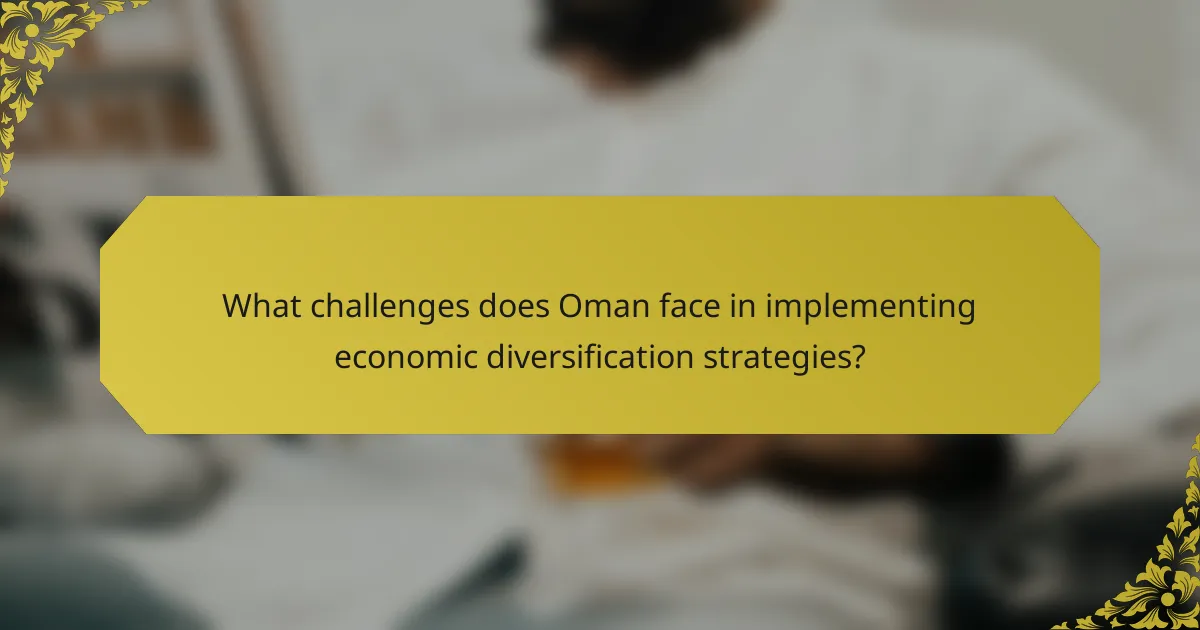
What challenges does Oman face in implementing economic diversification strategies?
Oman faces several challenges in implementing economic diversification strategies. A heavy reliance on oil revenues constitutes a significant barrier. Oil accounts for approximately 70% of government income. This dependence limits investment in alternative sectors. Additionally, there is a lack of skilled labor in non-oil industries. This skills gap hinders the growth of sectors like tourism and manufacturing. Regulatory and bureaucratic hurdles also complicate business operations. Complex processes deter foreign investment, which is crucial for diversification. Moreover, regional geopolitical tensions create an uncertain business environment. These factors collectively impede Oman’s efforts to diversify its economy effectively.
What are the main obstacles to successful diversification in Oman?
The main obstacles to successful diversification in Oman include limited access to financing, inadequate infrastructure, and a lack of skilled labor. Limited access to financing hinders the growth of new sectors. Many entrepreneurs struggle to secure loans or investment. Inadequate infrastructure affects the efficiency of operations in emerging industries. Poor transport and logistics systems create barriers to market access. A lack of skilled labor restricts the development of sectors like technology and manufacturing. The education system does not fully align with market needs. These obstacles collectively impede Oman’s efforts to diversify its economy away from oil dependency.
How does reliance on oil revenue hinder diversification efforts?
Reliance on oil revenue hinders diversification efforts by creating economic dependency. This dependency limits investment in other sectors, such as agriculture or tourism. When a nation relies heavily on oil, it often neglects to develop alternative industries. Consequently, this leads to a lack of innovation and reduced competitiveness in non-oil sectors. Historical data shows that countries with high oil dependence often experience slower economic growth when oil prices fluctuate. For instance, during oil price drops, economies reliant on oil revenue face significant budget deficits. This financial strain restricts government spending on diversification initiatives. Ultimately, the focus on oil revenue can stifle long-term economic resilience and adaptability.
What challenges exist in developing human capital for diversification?
Developing human capital for diversification faces several challenges. Limited access to quality education hampers skill development. Insufficient training programs fail to meet industry needs. There is often a lack of alignment between educational outcomes and labor market demands. Cultural resistance to change can inhibit the adoption of new skills. Additionally, inadequate investment in human capital leads to a skills gap. Economic fluctuations may also deter investment in workforce development. These challenges collectively hinder effective human capital development for successful diversification.
How do geopolitical factors impact Oman’s diversification strategies?
Geopolitical factors significantly influence Oman’s diversification strategies. Oman’s strategic location at the crossroads of major trade routes enhances its economic potential. Regional stability impacts foreign investment decisions, which are crucial for diversification. Tensions in the Gulf region can deter investors, affecting sectors like tourism and logistics. Additionally, Oman’s relationships with neighboring countries shape its trade agreements and partnerships. For instance, cooperation with the UAE and Saudi Arabia facilitates joint ventures. Furthermore, geopolitical alliances impact access to markets for Omani goods. The country’s participation in regional organizations promotes economic collaboration. Overall, geopolitical dynamics play a vital role in shaping Oman’s approach to economic diversification.
What external influences affect Oman’s economic decisions?
Oman’s economic decisions are influenced by various external factors. Key influences include global oil prices, as Oman is heavily reliant on oil exports. Fluctuations in oil prices can significantly impact government revenue and spending. Additionally, regional geopolitical stability affects foreign investment and trade relations. Economic policies of neighboring countries also play a role in shaping Oman’s economic strategies. Furthermore, international trade agreements can open new markets for Omani products. Global economic trends, such as demand for renewable energy, also influence Oman’s diversification efforts. Lastly, international financial institutions’ recommendations can guide fiscal policies and economic reforms.
How does regional stability play a role in diversification efforts?
Regional stability significantly influences diversification efforts by creating a favorable environment for investment and economic growth. Stable regions attract foreign direct investment, which is crucial for diversifying economies. For instance, Oman has benefited from its relatively stable political climate, encouraging investments in sectors beyond oil. According to the World Bank, stable governance leads to improved investor confidence. This confidence fosters innovation and the development of new industries. Moreover, regional stability enhances trade relations, allowing countries to explore new markets. In contrast, instability can deter investment and hinder diversification initiatives. Thus, regional stability is essential for successful economic diversification strategies.
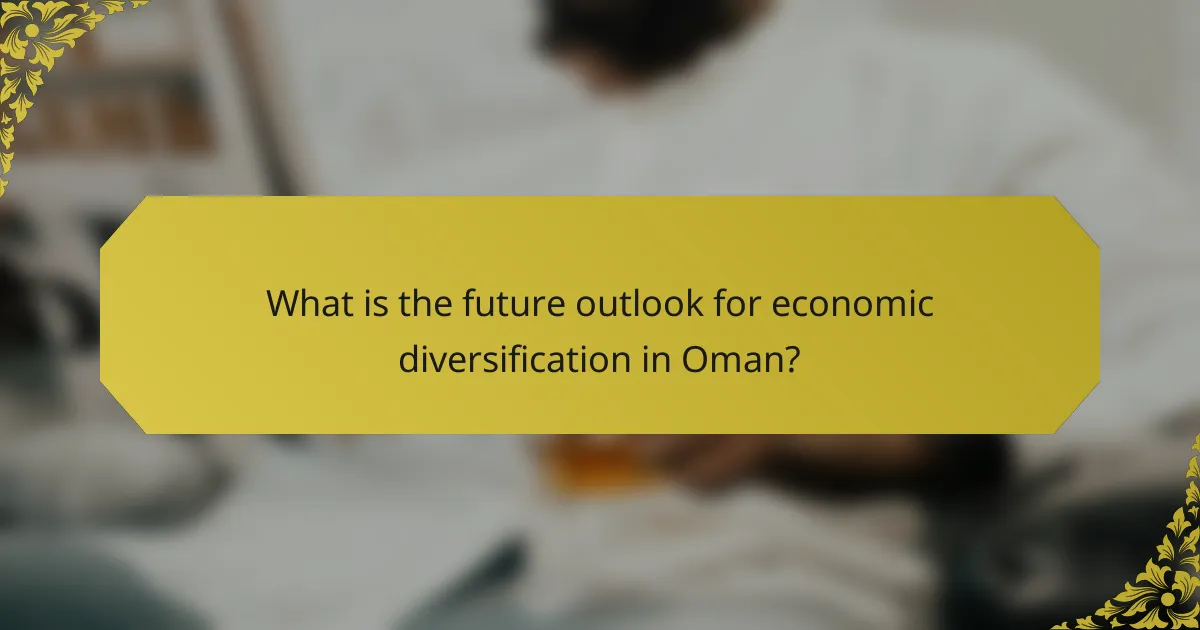
What is the future outlook for economic diversification in Oman?
The future outlook for economic diversification in Oman is promising but requires strategic implementation. Oman aims to reduce its dependence on oil revenue through various initiatives. The government has launched Vision 2040, focusing on sectors like tourism, logistics, and manufacturing. Investments in renewable energy are also prioritized to support sustainable growth. The non-oil sector has shown growth, contributing to GDP significantly in recent years. Challenges remain, including global economic fluctuations and regional competition. However, ongoing reforms and public-private partnerships provide a solid foundation for future success.
What trends are shaping the future of Oman’s economy?
Economic diversification is a key trend shaping the future of Oman’s economy. The government is actively reducing reliance on oil revenues. Initiatives are promoting sectors like tourism, logistics, and manufacturing. The Vision 2040 plan emphasizes sustainable development and innovation. Foreign investment is being encouraged through regulatory reforms. Renewable energy projects are gaining momentum, reflecting global sustainability trends. The Sultanate’s strategic location enhances its role in regional trade. These factors collectively indicate a transformative shift in Oman’s economic landscape.
How might technological advancements influence diversification strategies?
Technological advancements significantly influence diversification strategies by enabling new market opportunities and enhancing operational efficiency. For instance, emerging technologies like artificial intelligence and big data analytics allow businesses to identify and analyze market trends more effectively. This leads to informed decision-making regarding new product development and service offerings.
Additionally, advancements in communication technologies facilitate global reach and collaboration. Companies can now enter international markets with reduced barriers, broadening their customer base. Automation and digital tools also streamline production processes, reducing costs and increasing competitiveness.
Research shows that firms adopting technology-driven diversification strategies experience higher growth rates. According to a study by McKinsey & Company, companies utilizing advanced technologies can improve their innovation capabilities by up to 30%. This demonstrates that technological advancements are crucial for successful diversification strategies.
What role will sustainability play in Oman’s economic future?
Sustainability will play a crucial role in Oman’s economic future. It is essential for diversifying the economy beyond oil dependency. Oman aims to enhance renewable energy sources, such as solar and wind power. The government has set a target for renewable energy to comprise 30% of the energy mix by 2030. Sustainable practices in agriculture and fisheries are also being promoted. These practices help preserve natural resources and ensure food security. Furthermore, investments in sustainable tourism are expected to boost local economies. The focus on sustainability aligns with global trends and enhances Oman’s competitiveness.
What best practices can be adopted for successful economic diversification?
Successful economic diversification can be achieved through several best practices. First, fostering innovation is crucial. This can be supported by investing in research and development. Second, building a skilled workforce enhances the ability to adapt to new industries. Education and training programs are essential for this purpose. Third, establishing strong public-private partnerships can drive investment in diverse sectors. Collaboration between government and businesses encourages resource sharing and expertise. Fourth, creating a favorable regulatory environment attracts foreign investment. Simplified regulations can enhance business operations. Additionally, promoting entrepreneurship can stimulate economic growth. Providing access to funding and mentorship for startups is vital. Lastly, focusing on sustainable practices ensures long-term viability. Implementing environmentally friendly policies can enhance competitiveness. These best practices are supported by various case studies showing successful diversification outcomes in different regions.
How can Oman leverage its unique resources for diversification?
Oman can leverage its unique resources for diversification by focusing on tourism, fisheries, and renewable energy. The country has a rich cultural heritage and diverse landscapes, making it an attractive destination for tourists. In 2019, tourism contributed approximately 2.5% to Oman’s GDP. The fishing sector also holds potential, with Oman having access to abundant marine resources. The fisheries sector can enhance food security and create jobs. Additionally, Oman has significant solar and wind energy potential. The government aims to generate 30% of its energy from renewables by 2030. These sectors provide opportunities for economic diversification beyond oil dependency.
What strategies can enhance collaboration between sectors in Oman?
Enhancing collaboration between sectors in Oman can be achieved through several strategies. Establishing public-private partnerships can facilitate resource sharing and innovation. Implementing joint training programs can develop a skilled workforce that meets diverse sector needs. Encouraging knowledge exchange through workshops and forums can foster communication and collaboration. Creating a centralized digital platform can streamline information sharing between sectors. Promoting cross-sectoral projects can leverage strengths from different industries. Establishing regulatory frameworks that support collaboration can remove barriers. Lastly, incentivizing collaborative research and development initiatives can drive innovation across sectors. These strategies are essential for achieving economic diversification and sustainable growth in Oman.
Economic diversification strategies in Oman aim to reduce reliance on oil revenues by developing key sectors such as tourism, logistics, manufacturing, and agriculture. The government’s Vision 2040 outlines a roadmap for sustainable economic growth, emphasizing foreign investment and workforce development. This article explores the importance of diversification, its impact on Oman’s economy, success stories, challenges faced, and future outlook, highlighting the role of public-private partnerships and technological advancements in fostering resilience and sustainability. Key obstacles to diversification include oil dependency, lack of skilled labor, and geopolitical factors, which must be addressed to achieve long-term economic stability.
